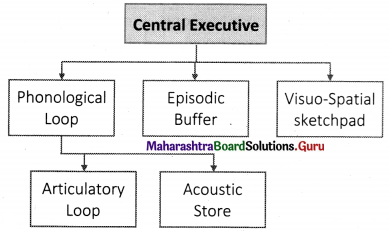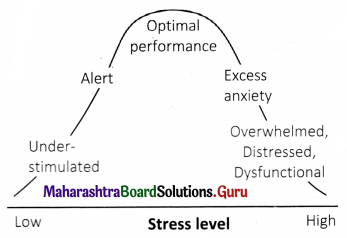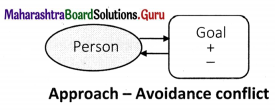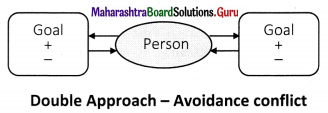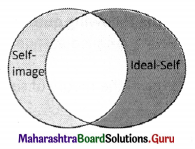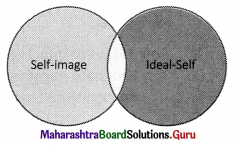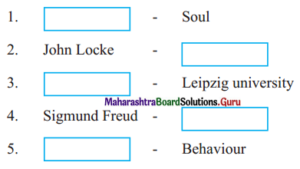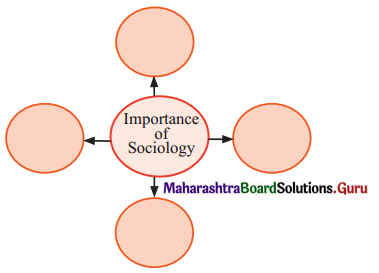Balbharti Maharashtra State Board Class 11 Sociology Solutions Chapter 8 Social Change Textbook Exercise Questions and Answers.
Maharashtra State Board Class 11 Sociology Solutions Chapter 8 Social Change
1. (A) Choose the correct alternative and complete the statements.
Question 1.
Social change as a term is ………………
(value loaded / ethically neutral / prejudiced)
Answer:
Ethically neutral
Question 2.
The effects of an earthquake on people is a ………………. factor of change.
(geographical / biological / cultural)
Answer:
geographical
![]()
Question 3.
The study of sex ratio is a ………………. factor of change.
(biological / technological / natural)
Answer:
biological
Question 4.
The slum rehabilitation programme within a city is an example of ………………… social change.
(planned / unplanned / revolutionary)
Ans.
planned
1. (B) Correct the incorrect pair.
Question 1.
(a) Earthquake – Biological
(b) Fundamentalism – Economic
(c) Growing Urbanization – Technological
(d) E-governance – Physical
Answer:
(b) Fundamentalism – Socio – cultural factor
1. (C) Identify the appropriate term from the given options.
(Physical Factor, Educational Factor, Economic Factor)
Question 1.
Impact of rising sea water level on coastal regions.
Answer:
Physical factor
Question 2.
Creating awareness about the problem of sexual abuse.
Answer:
Educational factor
1. (D) Correct the underlined words and complete the sentence.
Question 1.
Social change is a linear process.
Answer:
Social change is a continuous process.
Question 2.
All teachers are expected to think about how they will teach a unit in the classroom. This is an example of unplanned change.
Answer:
All teachers are expected to think about how they will teach a unit in the classroom. This is an example of planned change.
![]()
2. Differentiate between.
Question 1.
Planned change and unplanned change.
Answer:
| Planned change | Unplanned change |
| (i) Planned change occurs when purposeful changes are promoted by the government or other agencies. | (i) Unplanned change is a type of changes that is not planned. It happens suddenly. |
| (ii) In the case of planned cities in India, they have definite spaces marked for residence, parks, grounds, places of worship so on; the five years plans, educational plans, tribal welfare programmes, etc. | (ii) In the case of natural disaster, there is a loss of human and animal lives as well as property. Rehabilitation programmes have to be immediately designed and implemented for the affected persons. |
| (iii) Planned change occurs when deliberate decisions are taken to bring change. | (iii) Unplanned change is a result of unforeseen occurrences. |
| (iv) Planned social change is based on directions and goals. | (iv) Unplanned social change occurs without any directions or goals. |
Question 2.
Short-term change and Long-term change.
Answer:
| Short-term change | Long-term change |
| (i) Some social changes which may bring about immediate results are known as short-term change | (i) Some social change which may take years or decades to produce results are known as long-term change. |
| (ii) The purchase of new gadgets like home theatre for the purpose of entertainment within the home is rapid. | (ii) Giving up social evils like dowry, early marriage or domestic violence take decades to get rid of. |
| (iii) Short term change is change in material culture. | (iii) Long term change is change in non¬material culture. |
| (iv) Technological changes such as inventions and discovery play important role in bringing short term changes. | (iv) Social movements and revolutions play important role in bringing long term changes. |
![]()
3. Explain the following concept with an example.
Question 1.
Social change is interactional chain reaction
Answer:
1. A single factor may trigger a particular change, but it is almost associated with other factors like physical, biological, technological, cultural, social, economic, which may together bring about a social change.
2. This is due to mutual interdependence of social phenomenon.
Example : A huge increase in school fees will have an impact on student enrolment. It may further result in higher dropouts especially for the girl child from the system of school. Increase in school fees is an economic factor which may give rise to social factor like problems of girls dropout.
Technological factor of social change:
- Today, as we live in a digitalized world, we have been increasingly loaded with technology from our homes to our workplace.
- Technological changes have affected our social, economic, religious, political, and cultural life.
- Technological development creates new conditions of life and new conditions for adaptation. It continues to be an index of the overall progress of society.
Example : During the British period in India, systems of transportation and communication were laid. These may have served the needs of colonizers then, but we still continue to benefit from the systems.
Dysfunctional of social system:
- The social system may become dysfunctional at times.
- Hence, human beings have to make conscious efforts to help bring stability, balance and equilibrium in society.
Example : Emile Durkheim makes reference to anomic suicide where there is a state of normlessness or chaos, which can trigger off suicidal feelings that makes the social system dysfunctional.
Change in performance of social roles of individuals is also social change:
- The social system comprises of social institutions like education, government, economy, etc., they regulate human contact, allocate roles and provide resources.
- Social change also refers to change in performance of social roles of individuals according to changing times.
Example : In today’s Information Age, the role of a teacher in school is radically different than it was during the early Vedic period. There was marked differences in terms of the size of the school, learners, content of education, educational philosophy, methods of teaching and evaluation, etc.
![]()
Question 2.
Long term change
4. (A) Complete the concept maps.
Identify the significant factor of change for each.
Question 1.
| inventions | ——– |
| Effects of earthquake | ——– |
| Declining sex ratio | ——– |
| Student exchange programme | ——- |
| Cultural diffusion | ——– |
| Materialism | ——– |
Answer:
| inventions | Technological factor |
| Effects of earthquake | Physical factor |
| Declining sex ratio | Biological factor |
| Student exchange programme | Educational factor |
| Cultural diffusion | Socio – cultural factor |
| Materialism | Economic factor |
4. (B) State whether the following statements are true or false with reasons.
Question 1.
Prejudice and fear of the unknown is an obstacle to change.
Answer:
This statement is True.
- Sometimes people are not open to change as they are too comfortable within their life.
- Sometimes people don’t perceive the need to change prejudice or attitude towards a change also becomes obstacles.
- Fear of unknown leads people to avoid difference.
Hence, prejudice and fear of unknown is an obstacle to social change.
Question 2.
Social changes can be predicted accurately.
Answer:
This statement is False.
- The concept of social change involves a transition in society from one state to another through time. The change depends upon complex factors. Hence social change cannot be predicted accurately.
- Social change is not instant; it takes place over time. There is no inherent law of social change.
- The forces of social change may not remain the same and the process of social change does not remain uniform.
![]()
5. Give your personal response.
Question 1.
Do you think people do not accept change easily? Why?
Answer:
Yes, I think people do not accept change easily. Customs and traditions which are embedded in society do not allow people to accept new ideas and acts as an obstacle to social change. Sometimes lack of motivation or interest also causes hindrance to social change. Even though social change is universal, there are more often some quarters of resistance to change.
Question 2.
Do you think the Swachh Bharat Abhiyan has had a positive impact on society? Justify your response.
Answer:
The physical environment has also been adversely affected by human behaviour in the name of development. In this era of global warming and climate change, everyone is striving towards a clean and safe India. The campaign of clean India, i.e., the Swachh Bharat Abhiyan is the biggest step taken over as a cleanliness drive and has a huge possible impact on society.
11th Sociology Digest Chapter 8 Social Change Intext Questions and Answers
ACTIVITY (Textbook Page No. 83)
Question 1.
Do a Google search for ‘Punk Hairstyle’.
Answer:
Relate ‘Punk Hairstyle’ to cultural change in society. The inspiration for the hairstyle came from the punk rock music in the 70’s. People have long been in the practice of using hair dyes to change the colour of their hair as a means of making themselves more attractive. Punks use hair dyes to make themselves appear different from mainstream society. One of the most common punk hairstyles is the Mohawk and use of bright colours on the hair.
Question 2.
You have learnt about the physical factor of social change. Now, write one page about how the natural calamities affect the life of people and society by giving some suitable examples. (Textbook Page No. 86)
Answer:
Natural disaster in India, cause massive losses of life and property. Droughts, cyclones, landslides pose greatest threat. Landslides are common in the lower Himalayas. Parts of Western Ghats also suffer from low intensity landslides. Floods are the most common natural disaster in India. The heavy southwest monsoon rain causes the Brahmaputra and other rivers to over-cross their banks, often flooding the surrounding areas. The floods kill and displace many. Temperatures in three Indian cities of Chennai, Mumbai and Delhi in the last five decades have seen a steady rise. This rise in temperature has led to a higher incidence of natural disaster storms, floods and drought, which have increased. The cost of damages has gone up. The latest cyclone Vayu in Gujrat have led to widespread devastation along parts of the eastern coast of India.
Question 3.
Try to understand the meaning of globalisation and observe changes brought about by globalisation in the world around you. (Textbook Page No. 88)
Answer:
Globalization is a process of integrating a country’s economy with the world economy with a view to exploit global opportunities for local growth. Globalization has resulted in both advantage and disadvantage for the Indian society. On one hand it has promoted the process of industrialization but on the other small-scale industries are the worst affected by the entry of large-scale multinational companies. Though globalization has increased the export of Indian industrial and agricultural products, there are lot of hindrance in path of export.
Globalization has led to new and better employment opportunities but there has been also a negative impact of globalization on the employment situation in India, since it has to shift many of its workers from the organized sector to the unorganized sector of Indian economy. It has promoted international travel and tourism leading to cultural exchange.
![]()
Question 4.
You have understood the importance of technological factor of social change. Now, try to collect the data from ten families in your neighbourhood, about the use of modern technology in their day-to-day life. (Textbook Page No. 89)
Answer:
Students should attempt this question on their own.
Question 5.
Study the educational transformation in the last 10 years e.g., Teach for India campaign (Textbook Page No. 90)
Answer:
Teach for India campaign have transformed the lives of children in low-income communities.
They have re-imagined education by being holistic and differentiated such that every single child learns and grows to his or her fullest potential. 37,920 children have learned across Teach for India classrooms; They are committed to a singular goal – an excellent education for all children. Teach for India is striving to end the problem of educational inequality in India.
Question 6.
Trace changes in fashions and eating habits followed by teenagers in the past decade. Make a pictorial album or photo essay to show the changes. (Textbook Page No. 91)
Answer:
Students should attempt this question of their own.
